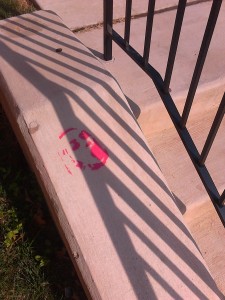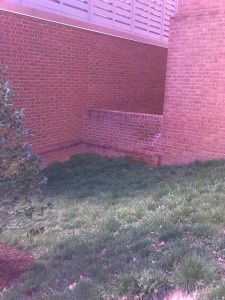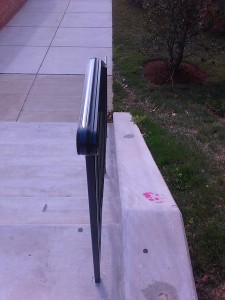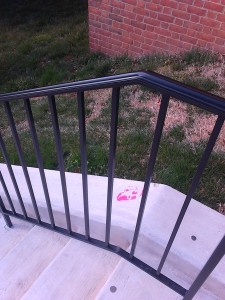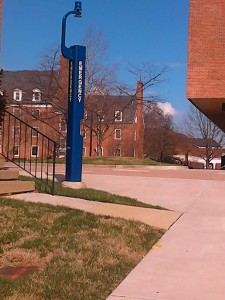This is a stencil of what I assume to be a screaming woman, spray-painted in hot pink. It’s located on the stairs that lead from campus to Lot 1, in between Tawes and the Art/Sociology Building (Google map here; you can even add your own graffiti sightings). I must have walked past it a million times without noticing it was there, because usually I am preoccupied with trying to see what art students are making in this door to the left of those stairs, which is open most of the time. [Lately it looks like someone in there is making a giant tree-person similar to the Ents in Lord of the Rings.]
To the right of the stairs is this little nook. Turns out that brick wall, which is almost as tall as me, overlooks a secret garage door into Tawes.
Here’s a shot approaching the cement staircase.
And here it is from the stairs themselves.
I have to say, even when you know this stencil is there and are looking for it, it’s still hard to find. I became dejected when I thought a small patch of cement farther down the stairs was covering up the image. I walked the path down to Lot 1 to make sure I wasn’t remembering the location wrong, looking up and down the poles of streetlights and along the edges of the concrete; people started looking at me as though I was missing something. It wasn’t until I had given up the search and was walking up the stairs toward Tawes that I saw it again. Then I realized that the stencil wasn’t anything like I remembered–I assumed the shape I was looking for was a figure of a woman, not her face, and I didn’t have a strong sense of its color.
This exercise was a reminder about the embodied memory of space and place. It’s so fickle yet it sometimes leaves such strong impressions. I walk this path almost every day, and I always look forward to seeing what’s going on in the workshop with the massive door–there are always lights, sounds, eye-catching shapes that sometimes dwarf the humans that are working on them. The best view is at night, when the door is open and the building is lit from within by fluorescents. I try to watch what’s going on without being noticed by the artists, which is difficult because the brick wall gets in the way unless you are standing at the top of the staircase [and then people behind you trying to use the stairs wonder why you're just standing there....]. But even after my joy at discovering this stenciled woman for the first time, my memory of her receded and she stopped catching my attention until I remembered her for this exercise.
Why would someone put a stencil there, and why this stencil? It’s a hard image to interpret. I think it’s a woman but this could be the illusion of long hair created by the hard line at the edge of the stencil. Her mouth is open but her expression seems neutral–her eyes are in shadow, not angry or afraid. Perhaps she just calls out for us to notice her while we’re absorbed in our phones or paying too careful attention to our feet on the stairs. Perhaps she calls our attention to the details of this most everyday of spaces: one pathway between campus life and the journey home. It’s a space we’re not supposed to inhabit for long, and it’s a place some people may never go because of their inability to access it. In some ways it’s for us as pedestrians but in other ways its utility is closed to us, considering that on most sides it is hemmed in by delivery entrances, parking lots, driveways, and storage for what keeps the buildings around it running.
Oh, and there’s this.
As part of an exercise for Dr. Farman’s course on Space, Place, and Identity, the class mapped the security cameras on campus. Some of them are freestanding, but some of them are attached to these emergency kiosks. It doesn’t quite look like this kiosk at the top of the stairs has a camera, but it occurred to me that whoever put that stencil there might have been caught in the process, under surveillance by invisible, and potentially not even human, eyes.

